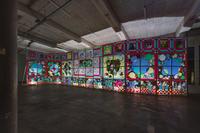Chapter 4OUR
Basilio (2019)
Simon(e) van Saarloos:
I try to imagine Raúl de Nieves’ stained glass works installed in a gothic catholic church, while most churchgoers would walk past it. Some would, however, stop to carefully look at it. The windows depict an apparently familiar narrative of heroes and mourning, but they also show galaxies, masks, and an ouroboros – a serpent eating its own tail, symbolizing eternity. De Nieves connects catholic traditions and Mexican tales with a personal and critical investigation of sexuality, colonial oppression, and underappreciated forms of knowledge such as oral history, quantum physics, astrology, and craft. De Nieves learned Latin American sewing and beadwork at school and from his family, and his work is a celebration of this tradition. By collecting materials and using them as decoration, the most mundane materials become spectacular and integral to the overpowering narrative spaces that De Nieves creates. Carnival starts – also in the Netherlands – with the recycling of existing materials, fabrics, and clothes. The masquerades embody a reversal of power relationships: during the festivities you’re not a worker but rather a queen. It’s this story of radical inversion and disruption of deeply felt truths, that I sense in De Nieves’ work.
Courtesy of Company Gallery and MOCA Miami
